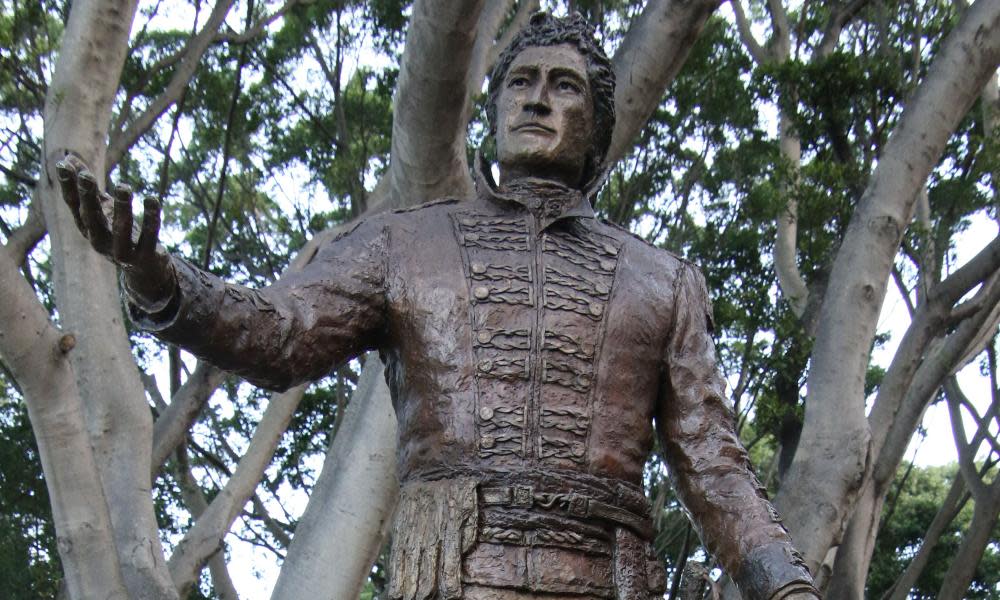It is high time there was an official monument to Indigenous victims of the frontier wars

Two hundred-and-five years ago British soldiers, following orders of the fifth governor of New South Wales, Lachlan Macquarie, massacred Dharawal men, women and children at Appin on the outskirts of today’s Sydney.
Macquarie is remembered in British and (white) Australian history as the great civiliser of the colony – an aesthete and town planner who brought early order to Sydney town, not least by imposing the great botanical and recreational space, Hyde Park, on Eora land.
But Macquarie was anything but a civiliser on 17 April 1816, when, in retaliation for Dharawal raids on the crops and livestock of the ever-expanding colony, they attacked the Aboriginal camp by the cliffs near Appin at dawn.
Related: The killing times: the massacres of Aboriginal people Australia must confront
Macquarie instructed: “On any occasion of seeing or falling in with the Natives ... they are to be called upon, by your friendly Native Guides, to surrender themselves to you as Prisoners of War. If they refuse to do so, make the least show of resistance, or attempt to run away from you, you will fire upon and compel them to surrender, breaking and destroying the Spears, Clubs and Waddies of all those you take Prisoners. Such natives as happen to be killed on such occasions, if grown up men, are to be hanged up on Trees in Conspicuous Situations, to Strike the Survivors with the greater terror.”
The British had long used such tactics of “terror” with ruthless efficiency elsewhere, including Ireland, to quell dissent.
Captain James Wallis, who led the raid, recounted: “I had ordered my men to take as many prisoners as possible and to be careful in sparing the women and children ... I regret to say some had been shot and others met their fate by rushing in despair over the precipice ... Fourteen dead bodies were counted in different directions ... I detached Lieut Parker with the bodies of [warriors] Durell and Kinnahygal to be hanged on a conspicuous part of a range of hills”.
Macquarie, meanwhile, ordered surviving children be removed to his so-called “Native Institution” in Parramatta – supposedly a school for “civilising” the Aboriginal young. So began the stealing of Aboriginal children.
The heads of Durell, Kanabygal and one woman were hacked off and sent as trophies to Edinburgh University. The heads were returned from Scotland in 1991 and stored at the national Museum of Australia’s Indigenous repatriation unit in Canberra.
This weekend a small crowd of Aboriginal and non-Indigenous people will remember the dead, at a ceremony by the modest memorial dedicated to the dead by the local Wollondilly Shire Council.
As the pastoral grab extended further west and north from Appin, the colonial and postcolonial massacres continued, with reliable estimates that some 60,000 Indigenous people (roughly the same as the number of Australian troops killed in the first world war) died in frontier conflict in Queensland alone.
There is no official Australian monument to those Indigenous dead.
A $500m Australian War Memorial expansion now seems a fait accompli. But a bigger memorial will not, it seems, make any significant allowance for history of Australian frontier war.
Related: When Glenda met Sandy: descendants of massacre survivor and soldier unite in grief
Many reasons have been offered for this, including that Australian frontier conflict did not amount to war. Odd. Macquarie himself mentioned his Aboriginal “Prisoners of War”.
The war memorial expansion will begin with the axing of at least 100 mature eucalyptus trees, some older than the 80-year-old AWM itself.
“They’ve seen more Anzac days than anyone here,” says historian Peter Stanley of heritage Guardians, a group opposed to the memorial expansion.
The notion of trees as sentient observers has deep roots in Indigenous culture. That is why they are sometimes planted in diamond formations at places of traditional significance like bora-, massacre- and burial-sites. A good example of such commemoration are the four trees planted by local Wuradjuri people in 2000 close to the grave of the warrior Windradyne, near Bathurst. He died in tribal conflict in 1829.
Which brings me back to Hyde Park at one edge of which stands a 2013 statue of Macquarie. A “perfect gentleman”, it calls him. No mention of his use of “terror” against the Dharawal.
Nearby, adjacent to the Anzac memorial, stand four paperbark trees. They have been deliberately planted closely in a diamond shape. They share a single mulch bed (most other trees in the park have their own beds of mulch).
The precise date of their planting – and who did so – is a mystery. But aerial photos indicate they went in the ground between 1943 and 1955.
Adam Joseph, a former federal Liberal adviser who has long agitated for a national monument to Indigenous frontier wars dead, has urged the City of Sydney to further investigate and protect the trees.
“The fact they were planted next to the Anzac monument, is an obvious statement to anyone with Aboriginal cultural awareness. This is the traditional signpost throughout most of NSW of an Aboriginal burial site. Since no bodies are buried there, it is patently a ‘Frontier Wars’ monument.”
These towering melaleucas have overseen many Anzac ceremonies in Hyde Park. Their very mystery allows them to stand, for some, as a poignant symbolic adornment to the gardens of Macquarie – architect of the Appin massacre.

 Yahoo News
Yahoo News 
